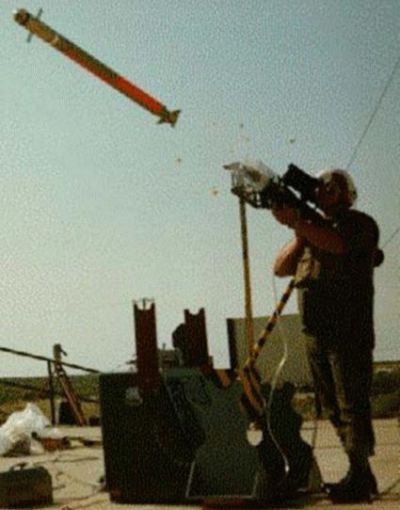Aircraft Vulnerability to Missiles
If a plane is hit by missile, can it still fly? Does it depend on the size of the plane and the missile?
Or where the plane is hit? What kind of missiles are more dangerous, radar guided or heat guided?
- question from name withheld
The answer to this question can be incredibly detailed, especially when written by someone who works in the field
of aircraft survivability. Aircraft survivability is the discipline that studies the "ability to withstand and
avoid a manmade threat environment." For those of you who are terribly impatient, the short answer is: "Of course
an airplane can still fly after it is hit by a missile." It hardly takes a rocket scientist to figure this one
out! After all, it was in November of 2003 when a DHL Airbus A300 was
struck by a surface-to-air missile and successfully landed at Baghdad International Airport. Of course, the size
of the plane and the missile do make a difference, and where the plane gets hit is probably even more important,
but the answers to those questions require a bit more complexity.

DHL Airbus A300 being attacked by a shoulder-launched IR guided missile
The area of survivability that is the most relevant to this discussion is vulnerability. Vulnerability is the
ability of an aircraft to continue to function even after suffering a hit from an enemy threat. This damage could
be caused by anything from simple small arms fire to an advanced surface-to-air missile (SAM). When engineers
design an aircraft, especially a military aircraft, they strive for a low vulnerability design. Before we can
really determine how to go about giving a new aircraft low vulnerability characteristics, it is best to consider
what systems on that aircraft contribute to its vulnerability. These are the five biggest concerns:
- Crew system (pilot and copilot)
- Flight control systems (control surfaces and hydraulics)
- Fuel systems (fuel tanks and fuel lines)
- Power train systems (propellers and rotors)
- Propulsion systems (engines)

F-18 that survived a missile hit to one of its engines
After looking at this list, we can start to figure out how to design an aircraft in order to reduce its
vulnerability. The main strategies for reducing vulnerability include redundancy, separation, and protection.
Redundancy suggests having more than one item that can do the same job. If you lose one, you have a backup.
Separation ties into redundancy, as it is best to have the redundant items widely separated so that a single threat
cannot disable both. Protection includes armoring a vital component such that it is more difficult to damage.
However, armoring isn't always preferred on aircraft since adding weight is rarely a good thing. Below are some
examples of how these strategies are often applied to counter each of the "big five."
1. Crew system:
- Armor the cockpit (protection)
Close support aircraft that fly at low altitudes are at greatest risk from small arms fire. Many such
planes include armor protection for key areas, like the cockpit. The
A-10 Warthog, for example, has a titanium "bathtub" surrounding
the pilot.
- Two pilots (redundancy)
Most bombers, transport planes, and helicopters have both a pilot and a copilot so that one can take
control of the vehicle in case the other is injured.
2. Flight control systems:
- Multiple separate systems (redundancy & separation)
Almost all modern aircraft have redundant hydraulic lines or fly-by-wire control systems routed separately
through different regions of the plane. These systems are completely independent so that damage to one
has minimal impact on the operation of the others.
- Control compensation (redundancy)
Researchers are investigating advanced control systems capable of detecting the changes in a plane's flight
characteristics due to damaged control surfaces. The flight control system then attempts to reconfigure
itself using the remaining control surfaces to compensate for the degradation in control authority. An
example of this advanced control system was the RESTORE software tested on NASA's
X-36 research plane.
3. Fuel systems:
- Self-sealing fuel tanks (protection)
Most military aircraft have used self-sealing fuel tanks since World War II, including the B-17 Flying
Fortress. These tanks contain an inner lining that minimizes the amount of fuel spilled from the tank
when it is punctured and helps prevent explosion.
- Inerted fuel tanks (protection)
Filling the airspace in a fuel tank with nitrogen gas reduces the risks of fire and explosion.
4. Power train systems:
- Multiple engines (redundancy & separation)
Aircraft with multiple engines can afford to lose one and still return to base. An example is the
four-engined C-130 Hercules.
- Hardened rotors and propellers (protection)
For helicopters, this is the only option. Rotor blades are typically designed to withstand significant
damage without failure. The rotors on the V-22 Osprey, for
example, are very resistant to damage from even large caliber projectiles.
5. Propulsion systems:
- Multiple engines (redundancy)
The Navy is particularly fond of redundant engines since naval aviators don't typically have many places to
land when an engine flames out. A good example is the
F/A-18 Hornet.
- Internal armor (protection)
Some aircraft make use of armor protection around engine bays to help reduce the likelihood of damage from
small arms fire.
After looking at these protection strategies, one might ask for a good example of a low vulnerability aircraft.
The B-17 of World War II is a good historical example. There are many stories of B-17s returning from missions
with massive damage, but they were able to remain in the air and bring their crews home.

B-17s that survived extensive damage during World War II
A modern example, and arguably the most low vulnerability aircraft in the world today, is the A-10 Warthog. This
aircraft has become famous for the considerable damage it took during the Gulf War and more recent conflicts
while still being able to return home safely.

A-10 damaged by small arms fire during Operation Iraqi Freedom
So, to answer the question that was asked, where a missile hits a plane is much more important than the size of the
plane. While it could be argued that being big has its advantages, since one missile is less likely to damage
multiple systems, a larger plane tends to be slower and less maneuverable, presenting a very nice target that is
easier to hit.
Now for round two--which kinds of missiles are more dangerous. Again, this is a complex issue that depends on
several variables. First, we will consider the two basic types of missiles. What you call heat guided missiles
are more accurately referred to as IR guided missiles since they home in on infrared energy. Radar guided missiles
are usually called RF guided missiles since they track radio frequency energy.
Since radar is better at tracking targets from great distances, RF guided missiles are usually used over much
longer ranges. These missiles are therefore typically larger and more expensive than their IR guided
counterparts. Consider the SA-2, for example, which many a Vietnam era pilot referred to as a flying telephone
pole, and it is certainly no exaggeration! Infrared radiation, on the other hand, is best used for guidane on
short range missiles. IR guided missiles, such as the man-portable Stinger, are typically much smaller with less
powerful warheads than RF guided missiles.

SA-2 RF guided surface-to-air missile
So, if we were to look at only the lethality of a missile (the amount of damage it can do) then RF guided missiles
would be the most dangerous. However, in the real world today, IR guided missiles and unguided weapons are the
primary threat. In the most recent military conflicts, the majority of aircraft kills have been made with IR
guided Man Portable Air Defense Systems (MANPADS), such as the Stinger or SA-7. Some of the most publicized kills,
like those portrayed in the film Blackhawk Down, have been scored with far less sophisticated unguided
weapons like rocket propelled grenades (RPGs).

Stinger man-portable IR guided surface-to-air missile
The effectiveness of MANPADS and unguided weapons can be attributed to three main reasons: cost, simplicity, and
stealthiness.
Cost: MANPADS and RPGs are much cheaper than RF guided missiles. While an RF missile
typically costs millions of dollars, MANPADS or RPGs may cost as little as thousands or even hundreds of
dollars.
Simplicity: MANPADS and RPGs require minimal training and little or no maintenance. There
is no radar dish or ground station equipment to maintain as required for radar-guided surface-to-air
missiles.
Stealthiness: MANPADS and RPGs are easily carried by one person, so it is very difficult to
avoid them. That farmer in the field could be picking corn, or he could be carrying an SA-7. MANPADS and
RPGs are also hard to detect. Most military aircraft are equipped with radar warning receivers that can
detect the radar signals emanated by an incoming RF guided missile. This warning provides the pilot time
to take evasive maneuvers or engage countermeasures. An IR missile, however, is completely passive,
meaning that it emits no radiation or other signal to warn the pilot. Unless the pilot or his wingman
happens to see the missile being launched, he likely has no idea that he's even been targeted. Due to
these reasons, and others, IR guided missiles are widely considered to be the most dangerous threat to
aircraft in modern warfare.
Let's now recap and summarize the main points of this answer.
- Planes can still fly after they are hit by a missile. Not all of the time mind you...
- Where a plane is hit is more important than the size of the plane. If you hit an aircraft in the
cockpit with a missile, it doesn't matter if it is a small F-16
or a massive C-5--it isn't going to be a good day!
- IR guided missiles are more dangerous in today's environment, even if they seem less dangerous when
compared in a one-on-one basis with their RF guided counterparts.
This article has covered some of the basic concepts of aircraft survivability. For additional information on this
subject, readers are referred to Dr. Robert Ball's book
The Fundamentals of
Aircraft Combat Survivability Analysis and Design.
- answer by Doug Jackson, 23 May 2004
Related Topics:
Read More Articles:









